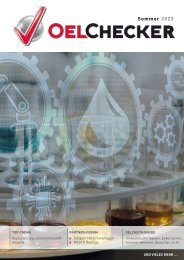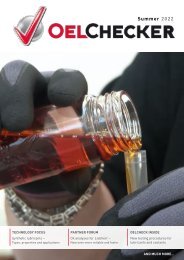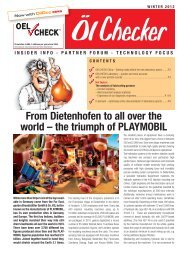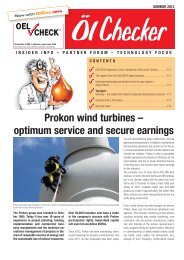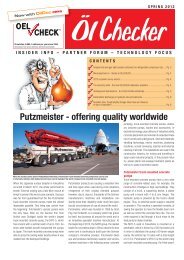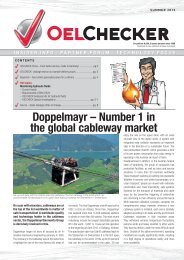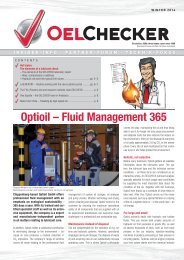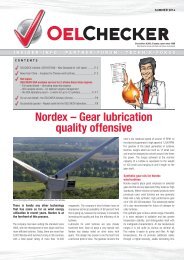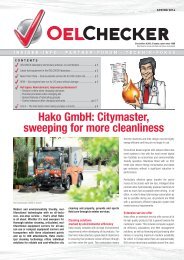OELCHECKER - Spring 2013
> Editorial – OELCHECK takes decisive steps for the years to come > OELCHECK – A strong brand with a new look > New services offered by the OELCHECK laboratory > Lubricants and condition monitoring – OELCHECK recognises trends > Gas engine oils – Latest information on oxidation determination > China – Opening of the OELCHECK laboratory in Guangzhou > Q & A – How can there be high levels of wear metals with normal purity classes? > OilDoc news
> Editorial – OELCHECK takes decisive steps for the years to come
> OELCHECK – A strong brand with a new look
> New services offered by the OELCHECK laboratory
> Lubricants and condition monitoring – OELCHECK recognises trends
> Gas engine oils – Latest information on oxidation determination
> China – Opening of the OELCHECK laboratory in Guangzhou
> Q & A – How can there be high levels of wear metals with normal purity classes?
> OilDoc news
- No tags were found...
You also want an ePaper? Increase the reach of your titles
YUMPU automatically turns print PDFs into web optimized ePapers that Google loves.
SPRING <strong>2013</strong><br />
IMPRINT<br />
For years we have been using your<br />
analyses to monitor the hydraulic<br />
fluids in our excavators. Poor oil purity,<br />
contamination or excessive water content<br />
have been found repeatedly. However,<br />
we recently received a laboratory<br />
report from you which shows high wear<br />
values but completely normal purity<br />
classes, to our considerable surprise.<br />
Shouldn‘t the purity of the fluid be<br />
significantly worse with a relatively<br />
large increase in wear metal?<br />
OELCHECK:<br />
This conclusion appears to be correct. In theory,<br />
all of the values should increase. However, this<br />
depends on whether the detected metals are<br />
really particles which originate from abrasive wear.<br />
In the case of your hydraulic excavators, this does<br />
not appear to be the case. The wear values which<br />
we measured, with higher levels of copper, chromium<br />
and iron, are clear. However, these metals<br />
do not result from the wear of bearings, pumps<br />
or valves. For example, a high level of iron or copper<br />
does not always mean that there is something<br />
Q & A<br />
wrong with the pump. Wear in a pump, when it<br />
does occur, is fostered by factors such as dust<br />
(silicon) or other wear particles. In such case, the<br />
purity class clearly indicates that the filtration is<br />
deficient.<br />
However, in a hydraulic system wear can also<br />
result from chemical processes. Lubricants and<br />
hydraulic fluids can attack elastomers, especially<br />
if the fluids contain synthetic components or detergent<br />
additives. Sealing rings and guide rings,<br />
hoses or other synthetic materials are composed<br />
of more than just plastic. In addition to the raw<br />
polymer, they contain up to 25 other components<br />
such as carbon black and oil, fillers and swelling<br />
agents, plasticisers, wetting agents, pigments or<br />
glide enhancers. There are good reasons why seal<br />
compatibility tests are specified in the standards<br />
for hydraulic fluids. If the „chemistry“ between<br />
the seals and the lubricant is not optimal, metallic<br />
elements may be dissolved out of the seal material.<br />
For example, O-rings may contain iron oxide,<br />
hoses may contain zinc oxide, or guide rings may<br />
contain chromium or copper compounds with particles<br />
in the nanoscale range. If these are leached<br />
out of the elastomer, they remain in solution in<br />
ÖlChecker – a magazine from OELCHECK GmbH<br />
Kerschelweg 28 · 83098 Brannenburg · Germany<br />
info@oelcheck.de · www.oelcheck.de<br />
All rights reserved. Reproduction without permission prohibited.<br />
Concept and text:<br />
Astrid Hackländer, Marketing & PR, 4600 Thalheim, Austria<br />
www.astridhacklaender.com<br />
Layout and design:<br />
Agentur Segel Setzen, Petra Bots, www.segel-setzen.com<br />
Photos:<br />
OELCHECK GmbH · Wirtgen Group · Bayernoil<br />
the oil. In the ICP tests used to determine approximately<br />
30 elements with particle sizes down<br />
to 3 μm, they appear in the laboratory report as<br />
elevated levels of iron, zinc, chromium or copper.<br />
Elastomer particles can be so extremely small that<br />
even in elaborate tests, such as those which we<br />
perform with scanning electron microscopy, we<br />
are unable to filter them out even with an especially<br />
fine filter with a pore size of only 0.25 μm.<br />
This also explains why they cannot be seen at all<br />
in the particle count. For the determination of the<br />
purity classes according to ISO 4406, particles<br />
are only counted if they are larger than 4 μm.<br />
If the levels of wear metals are outside the usual<br />
range but the purity classes indicate that better filtration<br />
is not required, we must rely strongly on our<br />
expertise and instinct. Our diagnostic engineers<br />
have extensive knowledge of where the elements<br />
or metal oxides dissolved in the oil may come from.<br />
Thanks to their experience and supported by the<br />
information in the large OELCHECK database, they<br />
can provide a clear indication of the origin of the<br />
elements, and if necessary they can point out the<br />
harmless wear of seals and guide rings without<br />
sounding an alarm about pump wear.<br />
If you have questions about tribology or lubricant analysis, OELCHECK can answer them.<br />
Send us your questions by e-mail (info@oelcheck.de) or by fax (+49 8034-9047-47).<br />
8<br />
For our engineering department we are looking for a<br />
Diagnostic Team Manager<br />
Your job profile<br />
You coordinate a team which presently consists of 6 engineers, and you ensure that the laboratory<br />
results with their comments are received by customers on the following day.<br />
You are responsible for the warning levels and limit values for oils and the plants in which they are<br />
used, and for related comments.<br />
You initiate measures to fulfil high demands for diagnostic services<br />
You assess and comment on laboratory findings on request and on your own initiative, and you<br />
generate diagnoses and expert reports for lubricants and machines.<br />
You use your expert knowledge of lubricants to provide technical advice to customers.<br />
Together with the chief scientist, you check the quality of the laboratory findings.<br />
You support our speakers at OilDoc Academy seminars or give talks yourself.<br />
As a department head you report directly to senior management.<br />
Your professional and personal skills<br />
As a qualified mechanical engineer you have profound knowledge of engines, plants and<br />
machinery in which lubricants are used.<br />
You have at least 5 years of professional experience in fields concerned with lubricants,<br />
lubrication technology or tribology.<br />
You are a team player, able to work under pressure, flexible and have management experience.<br />
You are able to respond quickly to enquiries from various sectors of industry.<br />
You are proficient with standard PC programs.<br />
OELCHECK is internationally active. You therefore have a very good knowledge of English.<br />
You are prepared to relocate to one of the most beautiful areas of Bavaria.<br />
Please send your complete application<br />
documents to:<br />
Barbara Weismann, OELCHECK GmbH<br />
Kerschelweg 28, 83098 Brannenburg, Germany<br />
For further information, visit www.oelcheck.de




